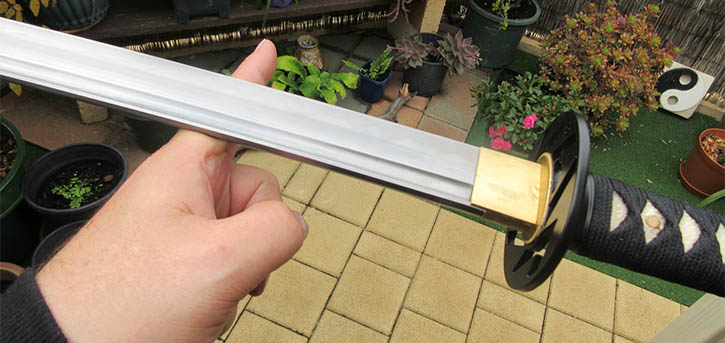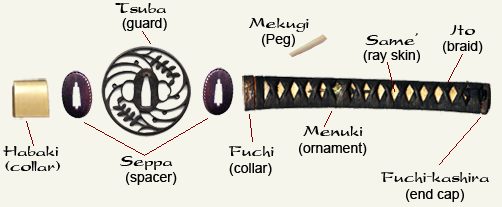By lyuesword | 11 November 2021 | 1 Comments
How Heavy Should A Sword's Blade Be?
A sword is comprised of two parts, a blade and a hilt. These two parts account for the length and weight of the sword. The hilt is designed to support the size of the blade. Swords are commonly seen as long bladed weapons that are used for slicing. While any sword can be designed for thrusting or slashing, there are specific blade types for both of these actions. Curved blades are found more commonly on slashing swords. These swords are designed with sharpened cutting edges on both sides of the blade. Straighter bladed swords are used for thrusting. Thursting swords have a sharpened tip. Bladesmiths, also known as swordsmiths, are specia-lized metal workers who create swords. When creating a sword there are four factors that bladesmiths must take into consideration for their design; balance, flexibility, hardness and strength.


Thickness of the swords blade directly effects its weight for the person using it. The average weight of a sword blade is 2.5 pounds. Some blades can weight 3.5 or 4.5 pounds. The hilt of the sword is the swords handle. The hilt is comprised of three parts, the pommel, guard and grip.
The pommel was originally created to prevent the sword from slipping from a persons grip. It is an enlarged fitting that is located at the top of the handle. The pommel serves other important uses to the person yielding the sword. The pummel is a counterweight to the blade, this helps create a balance when the sword is in use. Some swordsmiths would create a rather elongated pummel that could also be used as a weapon in addition to the swords blade. Swordsmiths have designed pommels in a large variety of shapes. They have been designed as crescents, wheels, spheres or even animal heads such as bird heads.

The handle of the sword is the grip. Metal and wood were the common ele-ments used for creating the grip and it was typically covered in an untanned tough leather called shagreen. Sometimes sharks skin was also used as a grip cover. Shark skin was very durable in mild climates but it would break down in hotter climates. From the 19th century on, rubber has been used as the most common grip cover. The grip cover is glued on to the handle of the sword; sometimes it is also fastened on with wire.

Early guards were created as a stopper on the sword that would prevent the users hand from slipping off the grip and upwards on the blade. A hand slip could cause serious injury. The cross-guard was created to provide safety to the users hands in the event of a strike. These guards eventually became known as cup hilts.
Not all weapons that contain blades are swords. Daggers are weapons with blades 14" or smaller, dirks are weapons with blades 14-20" in length, short swords have blade lengths of 20-28" and any blade over 28" is considered a longsword. These measurements refer only to western swords. Asian swords are extremely diverse consisting of straight, double edged Chinese long-swords and single edged Chinese sabers.
 The Katana is a Japanese slightly curved and single edged sword. The blade of the katana is only about 2.5 inches in length. Asian swards are most commonly used in modern day martial arts. Short swords are only about two feet in length, these historic swords were used in conjunction with shields. The spatha and gladius are common short swords. Scimitars, Falchions and Sabers are about 3 feet in length and are designed with a curved, single edged blade. These are popular military swords. The type of sword a person has depends solely on their intended use. Whether for collection, military or martial arts, swordsmiths create swords that can meet anyone's needs.
The Katana is a Japanese slightly curved and single edged sword. The blade of the katana is only about 2.5 inches in length. Asian swards are most commonly used in modern day martial arts. Short swords are only about two feet in length, these historic swords were used in conjunction with shields. The spatha and gladius are common short swords. Scimitars, Falchions and Sabers are about 3 feet in length and are designed with a curved, single edged blade. These are popular military swords. The type of sword a person has depends solely on their intended use. Whether for collection, military or martial arts, swordsmiths create swords that can meet anyone's needs.
Want a unique sword? Feel free to contact us:
Email: lyuesword@hotmail.com
Website: www.lyuesword.com
Custom Sword Page: www.lyuesword.com/Custom-Sword/customization-options/Create-Your-Own-Swords


Thickness of the swords blade directly effects its weight for the person using it. The average weight of a sword blade is 2.5 pounds. Some blades can weight 3.5 or 4.5 pounds. The hilt of the sword is the swords handle. The hilt is comprised of three parts, the pommel, guard and grip.
The pommel was originally created to prevent the sword from slipping from a persons grip. It is an enlarged fitting that is located at the top of the handle. The pommel serves other important uses to the person yielding the sword. The pummel is a counterweight to the blade, this helps create a balance when the sword is in use. Some swordsmiths would create a rather elongated pummel that could also be used as a weapon in addition to the swords blade. Swordsmiths have designed pommels in a large variety of shapes. They have been designed as crescents, wheels, spheres or even animal heads such as bird heads.

The handle of the sword is the grip. Metal and wood were the common ele-ments used for creating the grip and it was typically covered in an untanned tough leather called shagreen. Sometimes sharks skin was also used as a grip cover. Shark skin was very durable in mild climates but it would break down in hotter climates. From the 19th century on, rubber has been used as the most common grip cover. The grip cover is glued on to the handle of the sword; sometimes it is also fastened on with wire.

Early guards were created as a stopper on the sword that would prevent the users hand from slipping off the grip and upwards on the blade. A hand slip could cause serious injury. The cross-guard was created to provide safety to the users hands in the event of a strike. These guards eventually became known as cup hilts.
Not all weapons that contain blades are swords. Daggers are weapons with blades 14" or smaller, dirks are weapons with blades 14-20" in length, short swords have blade lengths of 20-28" and any blade over 28" is considered a longsword. These measurements refer only to western swords. Asian swords are extremely diverse consisting of straight, double edged Chinese long-swords and single edged Chinese sabers.
 The Katana is a Japanese slightly curved and single edged sword. The blade of the katana is only about 2.5 inches in length. Asian swards are most commonly used in modern day martial arts. Short swords are only about two feet in length, these historic swords were used in conjunction with shields. The spatha and gladius are common short swords. Scimitars, Falchions and Sabers are about 3 feet in length and are designed with a curved, single edged blade. These are popular military swords. The type of sword a person has depends solely on their intended use. Whether for collection, military or martial arts, swordsmiths create swords that can meet anyone's needs.
The Katana is a Japanese slightly curved and single edged sword. The blade of the katana is only about 2.5 inches in length. Asian swards are most commonly used in modern day martial arts. Short swords are only about two feet in length, these historic swords were used in conjunction with shields. The spatha and gladius are common short swords. Scimitars, Falchions and Sabers are about 3 feet in length and are designed with a curved, single edged blade. These are popular military swords. The type of sword a person has depends solely on their intended use. Whether for collection, military or martial arts, swordsmiths create swords that can meet anyone's needs.Want a unique sword? Feel free to contact us:
Email: lyuesword@hotmail.com
Website: www.lyuesword.com
Custom Sword Page: www.lyuesword.com/Custom-Sword/customization-options/Create-Your-Own-Swords
Recently Reviews
Read MoreLeave a Reply
Your email address will not be published.Required fields are marked. *